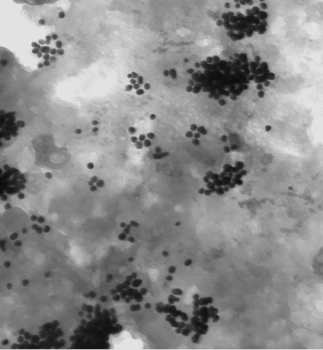Mention a breakthrough involving “gumbo” technology in this city, and people think of a new twist on The Local Dish, the stew that’s the quintessence of southern Louisiana cooking. But scientific presentations at a meeting of the world’s largest scientific society this week are focusing on what may be an advance in developing GUMBOS-based materials with far-reaching medical, electronic and other uses.
 The black dots in this image are nanoGUMBOS, some forms of which have been shown to selectively kill cancer cells using in vitro studies. (Credit: Isiah Warner, Ph.D. Click here for a high-resolution version)
The black dots in this image are nanoGUMBOS, some forms of which have been shown to selectively kill cancer cells using in vitro studies. (Credit: Isiah Warner, Ph.D. Click here for a high-resolution version)
The talks at the 245th National Meeting & Exposition of the American Chemical Society focused on what the scientists call a “Group of Uniform Materials Based on Organic Salts” (GUMBOS) and the nanoGUMBOS materials — particles so small that 100,000 could fit across the width of a human hair.
“We believe that these GUMBOS represent a truly different approach to micro- and nanotechnology,” said Professor Isiah Warner, Ph.D., of Louisiana State University (LSU) Baton Rouge, who led the scientific team that developed the first GUMBOS five years ago. “Unlike some products of the revolution in nanomaterials and nanotechnology, nanoGUMBOS can be designed for specific uses, rather than simply adapted for a particular use after being synthesized in the lab.”
Warner pointed out, for instance, that scientists are working on various types of nanoparticles for use in nanomedicine, especially to diagnose and treat cancer. In diagnosing cancer, nanoparticles with cancer-seeking properties might be injected into a patient before a medical scan. If even an early form of cancer were present, the particles would accumulate in the abnormal tissue and make it visible for early diagnosis and the best chances for recovery. For treating the disease, nanoparticles would preferentially collect in and destroy only the abnormal cells, sparing healthy tissue from the damage that triggers side effects with existing cancer chemotherapy. Warner acknowledges that his studies are not at this stage yet because, to date, all of their studies are based on in vitro measurements and are still currently under review.
Warner said that nanoGUMBOS technology allows scientists to produce new nanoparticles in a focused way such that these particles are produced for specific uses from the beginning. Some nanomaterials already use this approach. However, many nanoparticles developed so far for medical use, for instance, must be coated with other materials to provide the desired medicinal property. With GUMBOS technology, nanoparticles can have the desired property incorporated directly into the nanomaterial, he explained. For example, some nanoparticles are used as the drug delivery vehicle. “We can make nanoGUMBOS that are both the drug and the drug delivery vehicle,” he said.
Warner cited as one example a newly developed nanoGUMBOS material, with a provisional patent application filed, that his team at LSU foresees as a lead in possible development of new anti-cancer drugs. Using in vitro studies, they are completing key research to better understand how nanoGUMBOS can be tuned to be selectively toxic to cancer cells and non-toxic to normal cells. More details are presented on this technology at this New Orleans ACS meeting.
“We have a material that is normally toxic to both cancer cells and normal cells,” Warner explained. “If we introduce this material in vitro to normal cells, it kills them. Put them in the presence of cancer cells, it kills them. However, when we convert them to our GUMBOS, it only kills cancer cells. That’s basically how it works.”
In addition to biomedical applications, the materials also have potential uses in solar cells and as nanosensors and biomedical imaging reagents, Warner pointed out. Thus far, the scientists have made nanoGUMBOS in many shapes and sizes. For example, they can be spherical or shaped like rods or diamonds. Some nanoGUMBOS can fluoresce, or glow, while others are magnetic or conductive. Some can have multiple properties.
The organic salts used to make GUMBOS are not the familiar “organic sea salt” products sold for cooking and other uses. In chemistry, a salt is a substance formed when an acid neutralizes a base. Organic substances are simply those containing carbon. An example of an organic salt is one that forms when an organic acid reacts with and neutralizes a base. Some organic salts are common, but unseen, players in everyday life. Potassium bitartrate, for instance, forms naturally as wine ferments, trolamine salicylate is an ingredient in some sunscreens and cosmetic skin creams and monosodium glutamate is a food additive used to enhance the flavor of some foods.
In recognition of his work on GUMBOS and on the development of many innovative methods over the course of his career, Warner will receive the ACS Award in Analytical Chemistry sponsored by the Battelle Memorial Institute on April 9. He also will present an award address, a tutorial on the making and potential uses of GUMBOS.
The scientists acknowledged funding from the National Science Foundation.
The American Chemical Society is a nonprofit organization chartered by the U.S. Congress. With more than 163,000 members, ACS is the world’s largest scientific society and a global leader in providing access to chemistry-related research through its multiple databases, peer-reviewed journals and scientific conferences. Its main offices are in Washington, D.C., and Columbus, Ohio.
To automatically receive news releases from the American Chemical Society, contact [email protected].
Note to journalists: Please report that this research was presented at a meeting of the American Chemical Society.